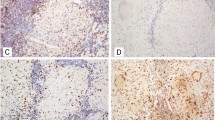Abstract Granuloma annulare, a prototype noninfectious granulomatous dermatitis, is morphologically characterized by a necrobiotic core surrounded by a cellular infiltrate. Because of many morphological similarities to tuberculosis, granuloma annulare has been suggested to represent a delayed-type hypersensitivity (Th1) reaction in the course of which inflammatory cells elicit matrix degradation. In the present study we (1) investigated the expression of interferon-Á as the most important Th1-associated cytokine, (2) sought in situ evidence for the coexpression of the proinflammatory cytokine tumor necrosis factor-· and cytokine-regulated matrix metalloproteinases 2 (gelatinase A) and 9 (gelatinase B), and (3) sought to determine whether shrunken cells seen within necrobiotic areas of granuloma annulare are apoptotic cells. In situ hybridization combined with immunofluorescence showed that large numbers of infiltrating CD3+ lymphocytes express interferon-Á. Application of catalyzed signal amplification in immunodetection revealed that the vast majority of CD3+ lymphocytes and CD68+ macrophages contained tumor necrosis factor-·. Immunohistochemistry demonstrated that macrophages producing tumor necrosis factor-· coexpress matrix metalloproteinases 2 and 9. In situ end-labeling combined with immunofluorescence detected few apoptotic T cells in perivascular regions and numerous apoptotic macrophages within necrobiotic areas. These results suggest that in granuloma annulare interferon-Á+ Th-1 lymphocytes may cause a delayed-type hypersensitivity reaction whereby macrophages are differentiated to aggressive effector cells expressing tumor necrosis factor-α and matrix metalloproteinases. In parallel, activation-induced apoptosis in lymphocytes and macrophages may serve to restrict the destructive potential of the inflammatory cells.
Similar content being viewed by others
Author information
Authors and Affiliations
Additional information
Received: 23 November 1999 / Received after revision: 28 March 2000 / Accepted: 14 April 2000
Rights and permissions
About this article
Cite this article
Fayyazi, A., Schweyer, S., Eichmeyer, B. et al. Expression of IFNγ, coexpression of TNFα and matrix metalloproteinases and apoptosis of T lymphocytes and macrophages in granuloma annulare. Arch Dermatol Res 292, 384–390 (2000). https://doi.org/10.1007/s004030000150
Issue Date:
DOI: https://doi.org/10.1007/s004030000150




